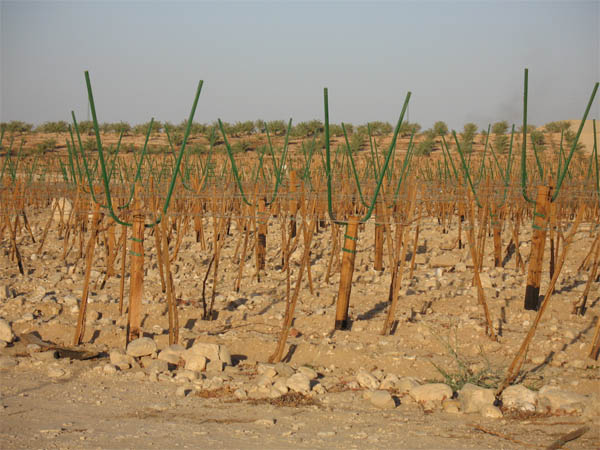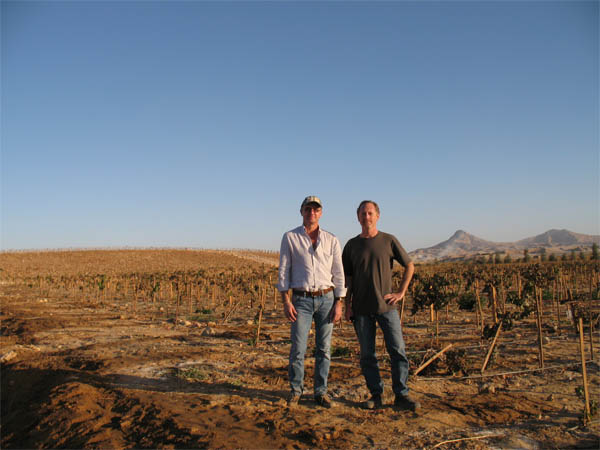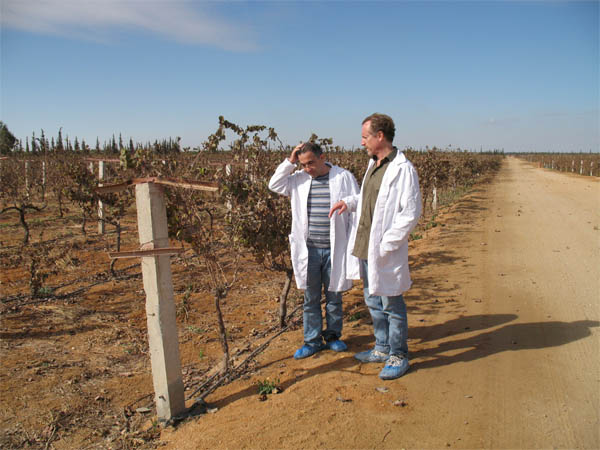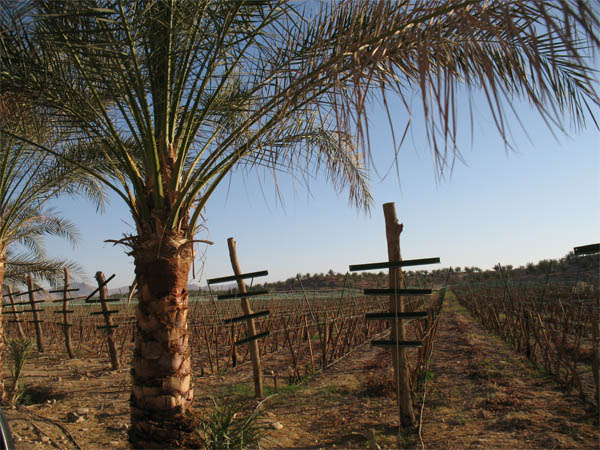Drink like an Egyptian?
Exploring the wine marvels of the ‘brave Old World’ it’s easy to follow the path laid out by cool climate viticulture. Certainly most of the world’s finest wines are grown in such conditions. But countries in South America and Southeast Asia have been blazing a trail for hot climate viticulture, an admirable if unenviable task. In addition Egypt is also at the forefront, writes BKWine Magazine’s contributor David Furer.
The Hwaidak family business
The Hwaidak family own one of Egypt’s most important travel companies, a business the elder son Karim still works within though most of his time and thoughts nowadays are now consumed with his Sahara Vineyards project. The German-Egyptian Hwaidak began the project in partnership with Al Ahram Beverage Company, a wholly-owned subsidiary of Heineken, to provide them with grapes for their premium wine line, Domaine de Gianacalis (an outgrowth of their older, larger, and more lucrative production from grape concentrate; between the two it has 60% of Egypt’s market share).Hwaidak retained the best for his Sahara line which includes the bottlings ‘Caspar’ and ‘Nermine, named for the young children of he and his wife Miriam.

As phylloxera is anathema in Egypt’s arid climate and sandy soils, most of Hwaidak’s 500 acres of vines are planted on their own rootstock. Most were double cordon/lyre-trellised in 2007 with another 66 of Syrah planted earlier in 2009. Hwaidak’s contiguous vineyards are located on the eastern outskirts of Luxor while the Gianacalis partnership’s Khatatba vineyards are located midpoint between Cairo and Alexandria.
The Nile Valley dilemma
A problem unique to the Nile Valley is the very fine, silty soil with salt patches that rise to the top only to wash away when irrigated. The salt problem is mitigated with the use of gypsum and sulfur additions help the water in carrying away the salts in the form of sodium sulfate. Hwaidak is keen on pursuing organic viticulture and has treated a nematode problem with a wild onion solution in the water supply. An energy- and water-saving method he’s employed is an underground irrigation system throughout the vineyards of as much as seven daily over four doses during May-June’s veraison.
He’s planted 18 varieties from France, Spain, and Italy. With the abundance of sun I was able to witness in December 2009 a cluster of fruit on a Chenin Blanc vine which was planted only that March! The most fascinating viticultural development I discovered is of Hwaidak’s experimenting with a few acres dedicated to reorienting the growing season to run October through June with dormancy taking place in the hottest period of July-September, in part by applying a chemical called ‘Dormix’ to delay budbreak.

The adage ‘90% of winemaking is done in the vineyard’ never had such resonance for me as it did sitting in on a meeting between Hwaidak’s Spanish consultants, José Luis Perez of Priorat’s Mas Martinet and his assistant, with three teetotalling Egyptian plant professors–Gehad El-Habbaa, Bahgat Helail, and Abdallah Abd Hadij–working with him.
“Temperature and, to a slightly lesser degree, soils are out of our control,” said Perez. As 22 tons/ha is the potential for the Khatatba vineyard with photosynthesis at nearly three times that of Burgundy managing excess vigor is essential. Compared to harvest temperatures in Europe sugar levels will rise steeply, phenolic ripening far more slowly. Harvest windows, especially for relatively thin-skinned varieties like Syrah, are narrow due to the rapid desiccation of grapes in the arid climate; regardless of the amount of irrigation it’s nearly impossible to keep up. Added hang-time here is an impossibility, the time between perfectly ripe and horribly overripe is too narrow. Reducing evaporation is critical, hence regular additions of compost during the dormant period both to increase soil density and balance soil nutrition.
Managing the conditions
A chance meeting at 2009’s Wine Future conference in Rioja Spain doubled my contacts in the land of the Nile. Co-owner André Hajj-Thomas and winemaker Labib Kallas, both Lebanese, of the Egyptian International Beverage Company (Egytas) were presenting a few vintages of their top-level ‘Jardin du Nil’ with mixed responses to the international crowd. An estimated 30,000 tourists enter Egypt every day, most of them Europeans consuming an average of 26 liters of wine per year.
André came to this country in 1999 at a time when the package tourism business was exploding and the need to create a lot of cheap & easy wine arose. With no wine grapes of consequence to call their own he and his colleagues (which include Samih Sawiris of the vast and diversified Orascom company) began importing bulk wine grape concentrate first from Europe, then from South America, which helped Egypt to gain the poor reputation I first read of in John & Erica Platter’s 2002 book, ‘Africa Uncorked: Travels in Extreme Wine Territory’. That same year that Egytas planted a few vines with most of the 500 acres coming in 2006, with a bit more in 2009. Kallas’ former professor at his Bordeaux university alma mater, Denis Dubourdieu, acts as Egytas’s consultant.
Located just outside the planned Red Sea resort town of Gouna (yes, its residents are referred to as ‘Gounies’), winemaker Kallas has lived close to his vineyards since 2005. He’s implemented relatively low-density plantings to allow for greater air circulation, something he insists also creates less competition for water amongst the vines. He’s found that, “irrigation’s best when done in short, large spurts in the mornings which train the roots to go deep. It’s so hot by 11am that both people and vines stop working, only to start again towards sunset.” Vineyards are managed organically, easy enough as mold pressures in this desert environment are non-existent. Pests are dealt with by the introduction of competing insects and supportive soil preparations. The soils are naturally alkaline with a high iron content.

As in most hot climate regions, wines here are plagued with green tannins in the reds and underripe acids in both whites and reds. “The grapes, because of the heat and sun, evaporate easily but don’t lose tannins so our reds can have double that of wines from cooler regions.” Kallas destems all bunches, blankets all tanks with nitrogen before imbuing them with wine, and uses computer- and temperature-controlled cellars & warehouses. A pre-fermentation addition of 1.5-2g/l of acid is a common practice unless he’s working with the aromatic, heat-resistant Vermentino, with an occasional post-fermentation citric or malic acid addition to the whites or roses to further correct taste. All wines are fermented to 2-2.5%rs.
The times they are a-changin’
In-country sales are brisk with most wines selling out before the new vintage is released so exporting isn’t a necessary but a way to accumulate reflected glory by encouraging visitors to relive their experiences once ensconced in their northern European or North American homes. “The all-inclusive tours can work against us as hotels then are reluctant to serve high-quality bottled wines. If they don’t then our potential export consumers won’t first be able try them here and relive their Egyptian experience,” said Hajj-Thomas. Sebastian Schwietzer, asst.
Food & Beverage Manager for Mövenpick’s Resort & Spa in Gouna, thinks that Egypt’s traditional culinary culture is becoming more important for his guests. “Egyptian wines make up 70%-80% of our wine sales, even in our speciality restaurant ‘El Sayadin’. Egyptian wine creators are realizing this trend and are adjusting their production accordingly.”
The Jardin du Nil signature white from ’09 contained a higher proportion of Vermentino than the ’08, a wise choice while the rosé, a blend of Montepulciano and Merlot, was refreshing and gluggable. The ’08 red was a passable if aggressively tannic 85% blend of Merlot and CS with the remainder comprised of Tempranillo, Nero d’Avola, and Montepulciano. A slightly curranty, licorice character shows along with softening tannins in the Jardin du Nil ’05 red while the ’07 had a bit of a spicy, tobacco character.

More recently Egytas has received a slew of medals from Millesimes Bio, Concours Mondial de Bruxelles, and Decanter World Wine Awards and has launched a traditional method sparkling wine in both white (100% Chardonnay) and rose (7% Pinot noir added to Chardonnay) called ‘Le Baron’- methode traditionnelle.
When tasted in 2009 I thought that Egyptian wines weren’t anything to get excited over. However there’s an identifiably steady increase in quality taking place in its 21st century wine renaissance. History is being re-made here.
This article was written by wine writer David Furer and has previously been published in a somewhat different version in Sommelier Journal.








One Response
Mr. Furer
It’s been interesting reading about Egyptian viticulture, growth characteristics and wine.
I’ll like to know more about Egypt’s viticulture areas.
I couldn’t have any notices about the real quantity of hectares cultivated for wine varieties – and the surface for each one – I estimated this is a smallest part of all their viticulture that is mainly for fresh consummation and raisins. Do you have any idea about the surface for all these vineyards?
It’s really interesting to know the magnitude of these cultivation areas to have an idea that can be near reality of this “spreading”.
Thank you
MONICA FIORILO